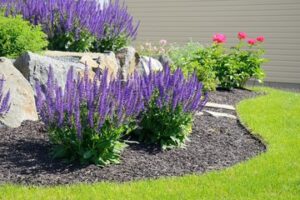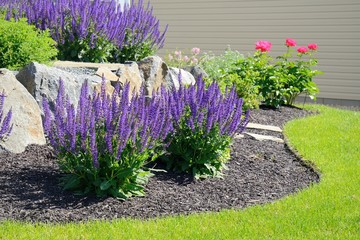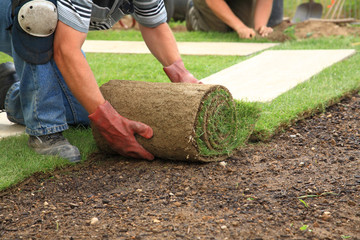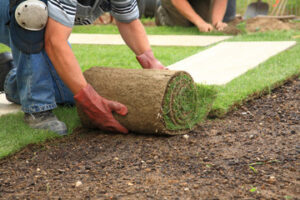Landscaping is much broader than gardening and includes the design, construction, maintenance, and management of outdoor environments. It involves choosing plants that thrive in the local climate and soil conditions, and incorporating structural elements like pathways, patios, water features, and walls.
Good landscape design creates a harmonious environment, adds value to the home, and provides enjoyment for its owners. Proper landscaping also reduces energy costs through wise use of natural resources and proper insulation. Contact Landscaping Springdale AR for professional help.
Traditional lawns are often monocultures consisting of only one species of grass. This lack of diversity can have a negative impact on local biodiversity as it prevents wildlife from finding food and shelter in these landscapes. In contrast, native landscapes offer a diversity of plants that support wildlife and provide habitat.
Additionally, a monoculture of grass is susceptible to many environmental pollutants such as pesticides, herbicides and fertilizers. In contrast, native landscaping is less likely to require these chemicals and helps reduce urban air pollution.
Many Western water providers are working toward the goal of getting rid of lawns and replacing them with more natural, native landscapes. Some are even offering rebates to encourage residents to swap out their water-thirsty grass for more drought-tolerant plants. This change will help to alleviate stress on local water resources, reduce the need for irrigation and protect the environment by reducing runoff and the amount of nitrogen and other contaminants entering rivers. Additionally, it can save residents money by lowering their water bills and helping to lower water rates for everyone in the community.
Trees
Trees add beauty to any garden and enhance the value of your home. They also provide many benefits such as providing shade, reducing energy costs, and protecting your home from high winds.
The roots of trees help absorb excess water, reducing soil erosion and flooding. In addition, they help replenish essential nutrients to the soil, promoting healthy plant growth. They also provide a natural means to reduce noise pollution by absorbing sound waves, making outdoor living spaces more tranquil.
Landscaping around trees can be challenging, but it is important to avoid damage to the roots. When planting, choose hardy shrubs and perennials that can survive in shady conditions. Avoid using mulch too close to the trunks, as this can restrict water and air flow to the roots.
When designing your landscape, consider using trees to screen unattractive features such as utility boxes, neighboring houses, or busy roads. Fast-growing trees can be a cost-effective solution and are more attractive than fences.
A variety of tree species are available for landscaping, including evergreens such as fir and pine. Other options include deciduous trees such as oak, hickory, and maple, and ornamental trees like crabapple and hawthorn. A good choice for Colorado’s climate is the Parkland Pillar Birch, which produces rich green foliage and golden yellow fall color. It is a narrow-growing tree that can grow to 40-60 feet tall and 20 feet wide.
Shrubs
Shrubs are a versatile landscape addition that can be used for a variety of purposes. They can add color and texture to the garden with their blooms, leaves and fruit while also offering a sense of privacy. There are many different types of shrubs and each one has its own unique characteristics. Some have beautiful evergreen foliage while others turn colors in the fall and are adorned with colorful berries.
Incorporating shrubs into a home landscape is an excellent way to increase property value. Research has shown that properties with well-cared for landscaping and plants have higher values than those without them. Shrubs are a great way to enhance the curb appeal of your home and can be used to create privacy fences and natural borders.
When selecting shrubs for your yard, it is important to consider their mature size and growth habits. It is also important to select a plant that will thrive in your climate and soil conditions. The gardening adage “the right plant in the right place” is especially true when it comes to shrubs.
Before planting shrubs, it is important to perform a site assessment to make sure the location gets adequate sunlight and rainfall. This will ensure the shrubs are able to grow well and will be able to accomplish the desired function. For example, evergreen shrubs such as boxwoods are popular for use in foundation plantings, edging and creating walls while juniper shrubs have a more traditional look and are often used to form hedges.
Flowers
Flowers add a pop of color and bring excitement to any garden or landscaping. They also help the environment by producing oxygen and absorbing carbon dioxide, as well as helping to control soil erosion. They attract insects, which helps pollinate other plants, promoting a healthy ecosystem and biodiversity.
Choosing the right flowers can make all the difference in your commercial landscape. Bright and cheerful blooms can increase employee productivity, boost customer satisfaction, and improve air quality. Incorporating flowers into your commercial landscape can also improve curb appeal and attract wildlife.
Choose perennial flowers that will come back year after year to provide a stunning display of color. For example, daylilies are a perfect addition to any garden or landscaping because they can withstand fluctuating temperatures and require little maintenance. They also come in a wide range of colors and sizes, so you can find the right one to fit your space.
Other options include bellflowers, which produce delicate bell-shaped flowers in shades of blue, pink, purple, or white and are ideal for cottage gardens and rockeries. They also flower in late spring or early summer, making them a symbol of hope and new beginnings. Another option is corydalis, which produces fern-like leaves and clusters of tubular flowers that resemble Queen Anne’s lace and are perfect for woodland and shade gardens. For a more colorful and lush commercial landscape, consider adding in clematis, bougainvillea, or mandevilla to your landscaping. These climbing flowers will quickly cover a pergola or fence to create a stunning backdrop for your flowers.
Irrigation
Irrigation is the artificial application of water to land or soil, typically for the purpose of keeping grass, shrubbery and flowers green and healthy. Irrigation systems are used for both residential and commercial landscaping projects and can reduce water usage by 30-50%.
The goal of irrigation is to provide the necessary amount of water in a timely manner to your plants, trees and turfgrass to prevent nutrient imbalances, stress, disease, soil salinity, root rot and drought. Irrigation also promotes plant health and helps protect your investment in landscaping by minimizing the need for costly replacement or repairs.
Compared to manual surface watering with a hose or a sprinkler attachment, an efficient irrigation system uses less water, provides more accurate coverage and saves you time.
Efficient Irrigation Saves Money
The most efficient irrigation systems are smart, which use a combination of sensors, controllers and water distribution mechanisms to deliver precise amounts of water directly to the roots of your landscape. They eliminate waste from overwatering and evaporation while reducing the risk of drought and overuse. Regular maintenance activities, like adjusting sprinkler heads and fixing leaks, also help to conserve water by eliminating waste and preventing runoff. A well-maintained irrigation system minimizes the need for repairs and ensures that your landscape stays beautiful with less water.
Xeriscaping
When people hear the term “xeriscaping,” they often imagine desert-style landscaping with rocks, gravel and cacti and succulent plants. The truth is that xeriscaping can be very beautiful and also save homeowners money by reducing water bills, maintenance costs, and the use of herbicides and other fertilizers for lawn care.
The best xeriscaping ideas focus on selecting plants that are native to the area and climate. These plants are adapted to the weather and soil conditions in that specific location, so they require less watering than non-native species. They also tend to be more resistant to diseases and pests than those introduced from outside the area, making them an ecologically responsible choice.
In addition, xeriscaping should focus on amending soil so that it retains water and nutrients well. Poor, dry soil lacks organic matter and is unable to absorb and drain water properly, so it can deprive even drought-tolerant plants of the water they need. Adding generous amounts of compost or organic matter to the soil can improve its ability to hold and drain water, helping reduce the need for supplemental irrigation.
Incorporating xeriscaping into your home’s landscape design can be done gradually. Start by replacing existing lawns with low-water plants that are suitable for your climate and site. As the plants grow and thrive, you can replace more and more areas with xeriscape plants. Remember to choose a variety of plant types to ensure your garden has color and texture all year round. A mix of perennials, vines climbing on trellises, and annual flowers helps provide continuous blooms throughout the season.


